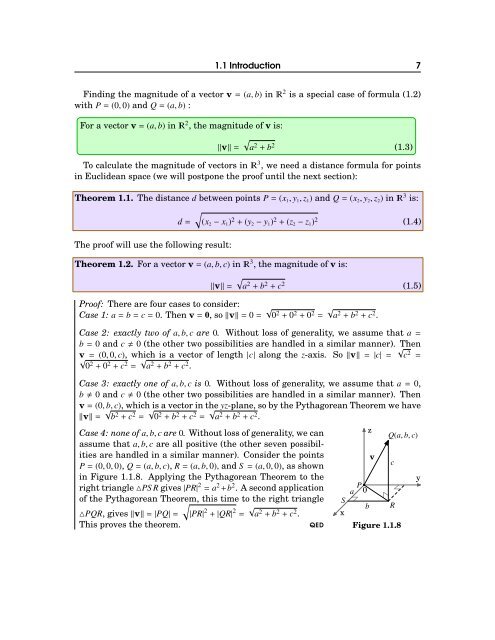Michael Corral: Vector Calculus
Michael Corral: Vector Calculus
Michael Corral: Vector Calculus
Create successful ePaper yourself
Turn your PDF publications into a flip-book with our unique Google optimized e-Paper software.
1.1 Introduction 7<br />
Finding the magnitude of a vector v=(a,b) in 2 is a special case of formula (1.2)<br />
with P=(0,0) and Q=(a,b) :<br />
For a vector v=(a,b) in 2 , the magnitude of v is:<br />
√<br />
‖v‖= a 2 +b 2 (1.3)<br />
To calculate the magnitude of vectors in 3 , we need a distance formula for points<br />
in Euclidean space (we will postpone the proof until the next section):<br />
Theorem 1.1. The distance d between points P=(x 1 ,y 1 ,z 1 ) and Q=(x 2 ,y 2 ,z 2 ) in 3 is:<br />
√<br />
d= (x 2 − x 1 ) 2 +(y 2 −y 1 ) 2 +(z 2 −z 1 ) 2 (1.4)<br />
The proof will use the following result:<br />
Theorem 1.2. For a vector v=(a,b,c) in 3 , the magnitude of v is:<br />
√<br />
‖v‖= a 2 +b 2 +c 2 (1.5)<br />
Proof: There are four cases to consider:<br />
Case 1: a=b=c=0. Then v=0, so‖v‖=0= √ 0 2 +0 2 +0 2 = √ a 2 +b 2 +c 2 .<br />
Case 2: exactly two of a,b,c are 0. Without loss of generality, we assume that a=<br />
b=0and c0(the other two possibilities are handled in a similar manner). Then<br />
v=(0,0,c), which is a vector of length|c| along the z-axis. So‖v‖=|c|= √ c 2 =<br />
√<br />
0 2 +0 2 +c 2 = √ a 2 +b 2 +c 2 .<br />
Case 3: exactly one of a,b,c is 0. Without loss of generality, we assume that a=0,<br />
b0and c0(the other two possibilities are handled in a similar manner). Then<br />
v=(0,b,c),whichisavectorintheyz-plane,sobythePythagoreanTheoremwehave<br />
‖v‖= √ b 2 +c 2 = √ 0 2 +b 2 +c 2 = √ a 2 +b 2 +c 2 .<br />
Case4: noneofa,b,care0. Withoutlossofgenerality,wecan<br />
assume that a,b,c are all positive (the other seven possibilities<br />
are handled in a similar manner). Consider the points<br />
P=(0,0,0), Q=(a,b,c), R=(a,b,0), and S= (a,0,0), as shown<br />
in Figure 1.1.8. Applying the Pythagorean Theorem to the<br />
righttriangle△PSRgives|PR| 2 = a 2 +b 2 . Asecondapplication<br />
of the Pythagorean Theorem,<br />
√<br />
this time to the right triangle<br />
△PQR, gives‖v‖=|PQ|= |PR| 2 +|QR| 2 = √ a 2 +b 2 +c 2 .<br />
This proves the theorem.<br />
QED<br />
z<br />
P<br />
a 0<br />
S<br />
b<br />
x<br />
v<br />
Q(a,b,c)<br />
c<br />
R<br />
Figure 1.1.8<br />
y








